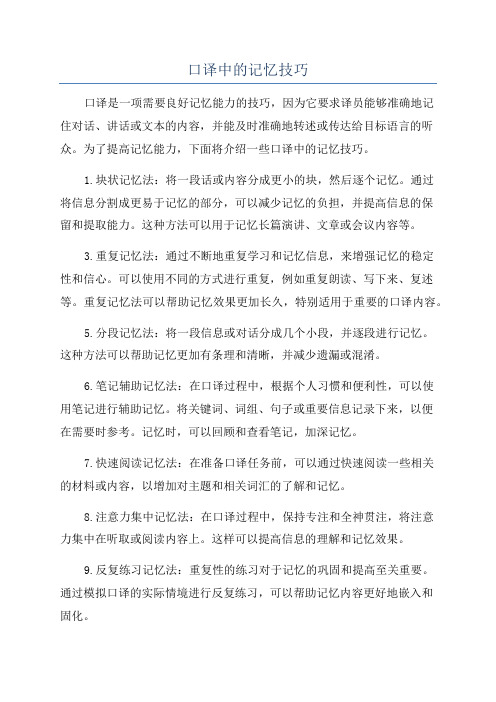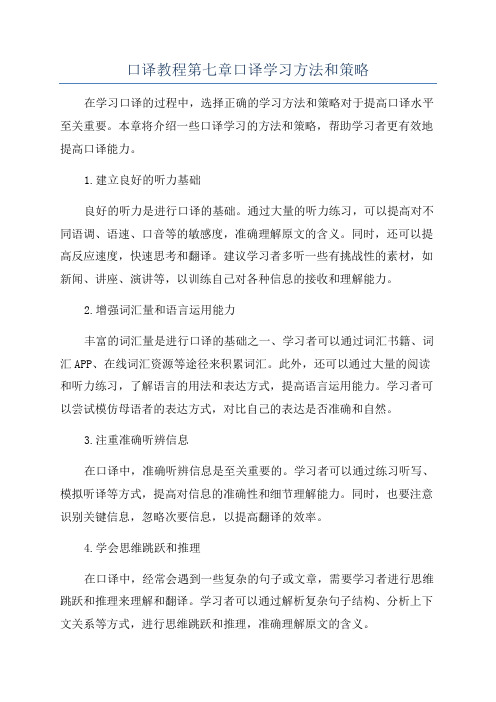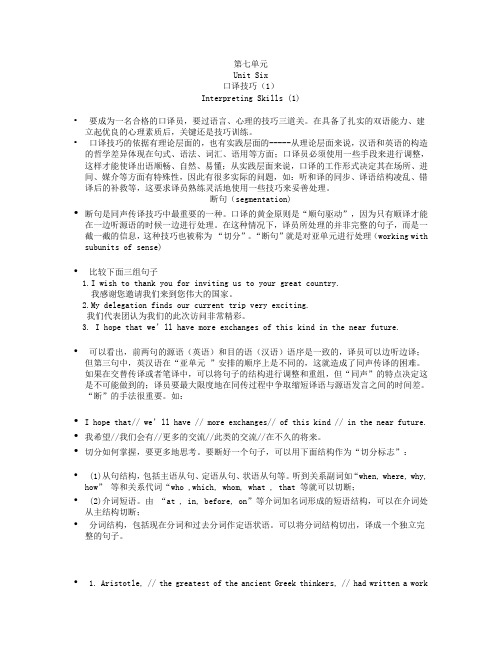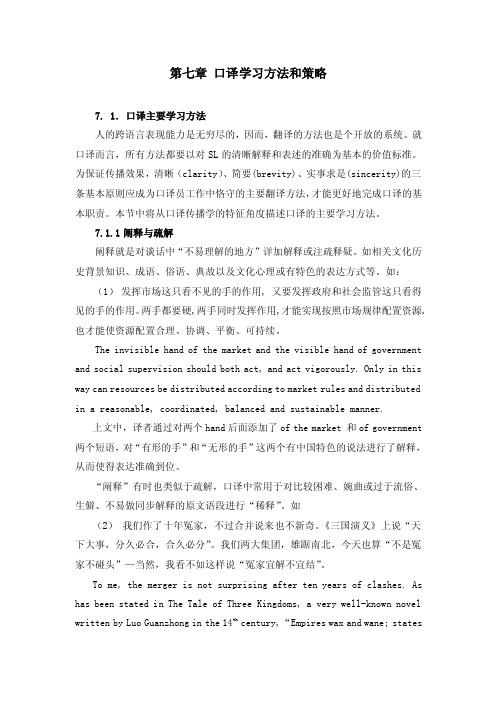第七章 口译技巧
口译的方法和技巧

口译的方法和技巧
口译是一种需要专业技能和深厚语言功底的工作,下面介绍一些口译的方法和技巧:
1. 熟悉语言环境:在口译前,需要对上下文和语境进行全面了解,这样才能更好地理解和表达原文的含义。
2. 听懂原文:在口译过程中,需要高度集中精神,听懂原文的意思,尤其是避免听错或误解原文内容。
3. 建立语言联系:在口译过程中,需要将源语言转换为目标语言,这需要在源语言和目标语言之间建立联系,从而更好地传达原文含义。
4. 注意语法和词汇:在口译过程中,需要注意语法和词汇的正确性,避免出现语法错误或用词不当的情况。
5. 流畅表达:在口译过程中,需要尽可能流畅地表达原文的含义,避免出现停顿、卡顿等问题。
6. 注意语音和语调:在口译过程中,需要注意语音和语调的正确性,从而更好地传达原文的情感和语气。
7. 练习和经验:口译是一种需要不断练习和经验积累的过程,只有不断地练习和经验积累,才能更好地提高自己的口译水平。
口译是一项需要高超技巧和深厚语言功底的工作,需要不断地学习和练习,才能做得更好。
口译技巧范文

口译技巧范文口译是一项需要高度专业技能和灵活应变能力的工作。
以下是一些口译技巧,可以帮助提升口译水平:1.备译知识在进行口译之前,务必要对相关领域的专业知识进行充分准备。
了解专业术语和行业背景能够帮助理解原文,并进行准确的口译。
2.集中注意力口译时需要全神贯注地听取原文内容,并进行实时翻译。
保持良好的专注力可以提高翻译的准确性和流畅度。
3.练习听力良好的听力是成功口译的基础。
通过大量的听力练习,可以提高对语速、发音和口音的敏感度,从而更好地理解原文。
4.提高反应速度口译需要在短时间内将原文翻译成目标语言,因此需要快速反应。
通过练习,提高自己的反应速度和口语表达能力。
5.掌握常用短语和固定搭配口译中经常使用各种常用短语和固定搭配,熟悉这些用法可以提高翻译的流畅性和准确性。
通过阅读、听力等方式积累相关词汇。
6.利用笔记和缩写在口译过程中,及时记录关键信息是十分重要的。
通过使用简洁明了的缩写和标记,可以更好地分类整理口译笔记,提高工作效率。
7.保持沟通交流与其他口译员、听众和演讲者保持良好的沟通和交流能力。
在口译过程中,及时发问和反馈可以帮助准确理解演讲者的意思,并进行准确的翻译。
8.学会同时听和说口译过程中需要两项任务同时进行:听原文和翻译目标语言。
练习同时听和说可以提高听力和口语表达的灵活性。
9.了解不同文化背景不同的文化背景对语言的使用和表达方式有着深刻影响。
了解不同文化的礼仪和习俗可以帮助更准确地理解并翻译原文。
10.多练习口译是一项需要不断实践和练习的技能。
通过参与口译培训、模拟口译和实际口译活动,不断提升口译水平。
以上是一些口译技巧,希望对口译爱好者有所帮助。
不断学习和提升技能是口译事业发展的关键。
翻译员的口译技巧与技巧

翻译员的口译技巧与技巧口译是一项需要高度专业技巧和良好语言能力的工作。
作为一名翻译员,口译技巧的掌握对于保证翻译的准确性和流畅性至关重要。
在本文中,我们将讨论口译中一些重要的技巧和策略。
1. 加强语言能力语言是口译的基础,翻译员需要掌握至少两种语言,并具备良好的听、说、读、写能力。
在口译中,需要迅速理解原文内容,然后翻译成另一种语言,因此,翻译员需要加强对词汇、语法和表达方式的理解和应用。
2. 倾听与理解在口译中,正确理解讲话者的意图和内容是至关重要的。
翻译员应当倾听并专注于原文的内容,避免出现误解或遗漏重要细节的情况。
同时,翻译员应当学会分析原文背后的含义和语境,以确保准确理解和传达。
3. 控制技巧口译中的控制技巧是指翻译员在口头表达上的技巧和策略。
翻译员需要能够快速思考并准确地转述原文,同时保持良好的语调、语速和节奏,并合理运用停顿、强调和修辞手法。
这样可以使翻译更具吸引力和清晰度。
4. 记忆力与临场应变能力为了保持口译的连贯性,翻译员需要具备较强的记忆力和临场应变能力。
记忆力可以帮助翻译员在口头表达时避免频繁地参考笔记或原文,而临场应变能力可以帮助翻译员应对突发情况和不可预测的语言表达。
5. 文化背景与跨文化沟通在跨语言交流中,文化背景的差异往往会对口译产生影响。
翻译员应当了解源语言和目标语言之间的文化差异,并遵循各自的语言习惯和礼仪规范。
在进行口译时,翻译员需要注重适应和调整,以便使翻译内容更符合目标语言的习惯和理解。
6. 求证与查询能力即使是经验丰富的翻译员也会遇到不熟悉的词汇或专业术语。
在这种情况下,翻译员不能猜测,而应当主动向讲话者求证或查阅相关词典和资料。
这样可以确保翻译的准确性和专业性。
7. 平衡表面词与意思词在口译中,有时需要平衡表面词和意思词,保持翻译的通顺度和地道性。
表面词是指表达句意的基本词汇和结构,而意思词则是指与原文最为接近的表达方式。
翻译员应根据语言习惯和交流需要,合理把握这两者之间的平衡。
翻译培训的口译技巧与文档翻译

译者应注重提高信息筛选和记忆能力,通过训练和实践来提高信息处理和 记忆水平。
语言表达技巧
01
语言表达是口译过程中最为关键的一环,要求译者能
够准确、流畅、自然地表达原文意思。
02
语言表达技巧包括注意语速、语调、语气等语言要素
译文应符合行业规范和标准,特别是法律、 医学等专业领域的文档。
文档翻译的流程与规范
准备阶段
熟悉原文涉及的主题和领域,收集相 关资料和术语,理解原文的语境和意 图。
翻译阶段
逐句翻译原文,确保准确传达原文含 义,同时保持译文的流畅性和一致性 。
校对阶段
检查译文是否存在错译、漏译、语法 错误、拼写错误等问题,并进行相应 的修改和润色。
文档翻译案例分析
文档翻译技巧
文档翻译需要掌握一定的翻译技巧,如理解原文、翻译准确、语言流畅等。通过对一些成功的文档翻 译案例进行分析,可以总结出一些实用的翻译技巧和方法。
文档翻译经验
分享一些成功的文档翻译经验,如如何处理专业术语、如何保证译文质量等,以帮助其他译者提高自 己的翻译水平。
跨文化交流案例分析
借助先进技术工具
利用人工智能和机器学习技术,提高翻译的效率和准确性 。同时,结合传统翻译方法和新技术工具,实现更加高效 、高质量的翻译服务。
THANKS
感谢观看
口译与文档翻译的未来发展趋势
随着科技的不断进步,口译和文档翻 译将更加依赖于人工智能和机器学习 技术。这些技术将有助于提高翻译的 准确性和效率,减少人工干预。
未来,口译和文档翻译将更加注重跨 文化交际能力的培养。译者在传递信 息的同时,还需要考虑文化差异、语 境等因素,以实现更加自然、流畅的 交流。
口译中的记忆技巧

口译中的记忆技巧口译是一项需要良好记忆能力的技巧,因为它要求译员能够准确地记住对话、讲话或文本的内容,并能及时准确地转述或传达给目标语言的听众。
为了提高记忆能力,下面将介绍一些口译中的记忆技巧。
1.块状记忆法:将一段话或内容分成更小的块,然后逐个记忆。
通过将信息分割成更易于记忆的部分,可以减少记忆的负担,并提高信息的保留和提取能力。
这种方法可以用于记忆长篇演讲、文章或会议内容等。
3.重复记忆法:通过不断地重复学习和记忆信息,来增强记忆的稳定性和信心。
可以使用不同的方式进行重复,例如重复朗读、写下来、复述等。
重复记忆法可以帮助记忆效果更加长久,特别适用于重要的口译内容。
5.分段记忆法:将一段信息或对话分成几个小段,并逐段进行记忆。
这种方法可以帮助记忆更加有条理和清晰,并减少遗漏或混淆。
6.笔记辅助记忆法:在口译过程中,根据个人习惯和便利性,可以使用笔记进行辅助记忆。
将关键词、词组、句子或重要信息记录下来,以便在需要时参考。
记忆时,可以回顾和查看笔记,加深记忆。
7.快速阅读记忆法:在准备口译任务前,可以通过快速阅读一些相关的材料或内容,以增加对主题和相关词汇的了解和记忆。
8.注意力集中记忆法:在口译过程中,保持专注和全神贯注,将注意力集中在听取或阅读内容上。
这样可以提高信息的理解和记忆效果。
9.反复练习记忆法:重复性的练习对于记忆的巩固和提高至关重要。
通过模拟口译的实际情境进行反复练习,可以帮助记忆内容更好地嵌入和固化。
总结起来,提高口译记忆能力的关键是选择适合自己的记忆方法,并将其应用于口译的实践中。
不同的方法可以结合使用,以达到最佳的记忆效果。
此外,良好的口译记忆还需要持续的练习和努力,通过不断地实践和反馈来改进和提高。
口译技巧知识点总结

口译技巧知识点总结一、语言能力1. 语言能力是进行口译的基础,口译员应该具备良好的听、说、读、写的能力,同时还需要有较强的语言表达能力和纠错能力。
2. 口译员需要熟练掌握至少一门外语,务必达到一定的语言水平,同时需要对所要翻译的内容有一定的了解,以便更好地理解并传达所翻译的内容。
3. 口译员需要丰富的词汇量,以应对各种专业领域的口译需求,同时还需要注重对词语的精准使用,避免翻译中出现偏差。
4. 在进行口译时要保持层次清晰,语速适中,尽可能使翻译听起来自然流畅。
二、文化背景1. 口译员需要具备良好的文化素养,了解不同国家的文化差异和礼仪习惯,以便在口译过程中更准确地传达意思。
2. 口译员要对所要翻译的内容具有一定的了解,尤其是对当地的政治、经济、历史、社会等方面的知识有一定的掌握。
3. 在进行口译时,要尽量避免使用不当的词语或表达方式,以免引起对方的误解或不适。
4. 在进行跨文化口译时,要有意识地对文化背景进行调整,以便更好地传达意思。
三、专业知识1. 口译员需要有较强的学习能力和理解能力,能够在短时间内快速理解并翻译所需内容。
2. 口译员需要对专业知识有一定了解,尤其是在特定领域的口译需求,比如医学、法律、商业等方面的知识,以便更好地进行专业口译。
3. 在口译过程中要注重专业术语的准确使用,避免因专业术语的错误而导致对方的误解。
4. 口译员要不断学习、积累经验,不断提升自己的专业水平。
四、沟通技巧1. 口译员需要具备良好的沟通能力,能够清晰、准确地传达双方的信息。
2. 在进行口译时,要注重适当的交流,以便更好地理解对方的意思,同时也需要注重对对方的态度、语气等细微表达的观察与解读,以便更好地传达对方的意思。
3. 在进行口译时,要注重文字与语音的配合,注重口型和声音的配合,以便更好地传达意思。
4. 口译员要注意表达方式的转换,即根据对方的语言和表达方式,进行相应的语言和表达方式的转换,以便更好地与对方相互沟通。
《英语翻译教案》课件

《英语翻译教案》PPT课件第一章:翻译的基本概念1.1 翻译的定义解释翻译的概念强调翻译的目的是传递信息和文化1.2 翻译的类型介绍不同类型的翻译,如直译、意译、同声传译等解释每种翻译类型的特点和应用场景1.3 翻译的标准和原则介绍翻译的标准,如准确性、可读性、忠实原文等强调翻译时应遵循的原则,如保持原文的意义和风格第二章:翻译的基本技巧2.1 词汇翻译技巧解释词汇翻译的基本原则,如词义选择、词性转换等举例说明常用翻译技巧,如直译、意译、借译等2.2 句子翻译技巧介绍句子翻译的基本原则,如句子结构对等、语序调整等举例说明常用翻译技巧,如被动语态的转换、从句的翻译等2.3 段落和文章翻译技巧解释段落和文章翻译的基本原则,如连贯性、一致性等举例说明常用翻译技巧,如段落结构的调整、文章风格的保持等第三章:英语语法和句型3.1 英语语法基本概念介绍英语语法的基本概念,如时态、语态、语气等强调语法在翻译中的重要性3.2 英语句型结构解释英语句型的基本结构,如主谓宾结构、主谓表结构等举例说明不同句型的翻译方法3.3 英语特殊句型和短语介绍英语特殊句型和短语的翻译方法,如倒装句、省略句等举例说明常用特殊句型和短语的翻译技巧第四章:文化差异与翻译4.1 文化差异对翻译的影响解释文化差异对翻译的影响,如语言表达习惯、文化背景知识等强调翻译时应注意文化差异的重要性4.2 英语和汉语的文化差异举例说明英语和汉语在词汇、表达方式、语法等方面的文化差异强调翻译时应考虑目标语言的文化背景4.3 翻译中的文化适应和调整介绍翻译中如何进行文化适应和调整,如词义选择、增减内容等举例说明文化适应和调整的翻译技巧第五章:翻译实践与评价5.1 翻译实践的重要性强调翻译实践在学习和提高翻译能力中的重要性鼓励学生积极参与翻译实践,提高翻译技能5.2 翻译评价的标准和方法介绍翻译评价的标准,如准确性、流畅性、忠实原文等解释翻译评价的方法,如同行评审、自我评价等5.3 翻译实践案例分析提供翻译实践案例,让学生进行翻译和评价分析案例中的翻译优点和不足,提供改进建议第六章:翻译软件与工具6.1 翻译软件的概述介绍目前市面上常见的翻译软件和工具,如谷歌翻译、DeepL等强调翻译软件在辅助翻译工作中的作用6.2 翻译软件的使用方法详细讲解如何使用翻译软件进行翻译强调翻译软件的局限性,如准确性、语境理解等6.3 翻译软件与人工翻译的结合介绍如何将翻译软件与人工翻译相结合,以提高翻译效率强调翻译软件只能作为辅助工具,不能完全替代人工翻译第七章:口译技巧与实践7.1 口译的基本概念解释口译的概念和类型,如同声传译、交替传译等强调口译的特点,如即时性、准确性等7.2 口译技巧介绍口译技巧,如听力训练、短期记忆训练、语言表达训练等强调口译技巧在实际口译工作中的重要性7.3 口译实践与评价提供一个口译实践案例,让学生进行口译练习分析案例中的口译优点和不足,提供改进建议第八章:商务翻译技巧8.1 商务翻译的特点解释商务翻译的特点,如专业性、实用性、准确性等强调商务翻译在实际工作中的重要性8.2 商务翻译技巧介绍商务翻译技巧,如术语准确运用、句子结构优化等举例说明商务翻译中常用的翻译技巧8.3 商务翻译实践与评价提供一份商务翻译案例,让学生进行翻译练习分析案例中的翻译优点和不足,提供改进建议第九章:文学作品翻译技巧9.1 文学作品翻译的特点解释文学作品翻译的特点,如艺术性、想象力、文化适应等强调文学作品翻译在文化传承中的重要性9.2 文学作品翻译技巧介绍文学作品翻译技巧,如词义选择、形象表达等举例说明文学作品翻译中常用的翻译技巧9.3 文学作品翻译实践与评价提供一篇文学作品翻译案例,让学生进行翻译练习分析案例中的翻译优点和不足,提供改进建议第十章:翻译职业规划与发展10.1 翻译职业概述介绍翻译职业的现状和发展趋势强调翻译职业的重要性和前景10.2 翻译职业技能要求解释翻译职业技能的要求,如语言能力、翻译技巧、跨文化交际能力等强调翻译职业技能在实际工作中的重要性10.3 翻译职业规划与发展介绍翻译职业规划的方法和建议,如持续学习、拓展业务领域等强调翻译职业发展的关键因素,如个人能力、市场需求等重点和难点解析重点环节一:翻译的类型和标准翻译类型:直译、意译、同声传译等,以及它们的定义和应用场景。
语言翻译中的口译与笔译技巧与方法

语言翻译中的口译与笔译技巧与方法在语言翻译领域中,口译和笔译都扮演着重要的角色。
口译是指将一种语言口头表达转化为另一种语言口头表达的过程,而笔译则是将一种语言的书面表达转化为另一种语言的书面表达的过程。
无论是从事口译还是笔译,掌握一定的技巧与方法都是非常必要的。
在本文中,我们将探讨语言翻译中的口译与笔译技巧与方法。
一、口译技巧与方法1. 准备工作在进行口译之前,进行充分的准备工作非常重要。
首先,需要对相关领域的背景知识有一定的了解,比如在进行医学会议的口译时,需要提前了解相关医学术语和知识。
此外,对于参加活动的演讲嘉宾或与会者的相关资料进行了解也是必要的,这有助于提前准备相应的词汇和表达方式。
2. 注意听和记笔记在口译过程中,注意力和记忆力是非常关键的。
口译员需要保持高度的专注和集中注意力,全神贯注地听取讲话者的表达。
同时,及时进行适当的笔记,记录重要信息和关键词汇,有助于回顾和整理口译内容。
3. 分析与转化在口译过程中,往往需要将讲话者的意思和表达方式转化为另一种语言,因此分析与转化能力是非常重要的。
口译员需要理解讲话者的目的和观点,并找到合适的方式将其转化为另一种语言的表达。
积累丰富的词汇和短语,灵活运用不同的表达方式,能够更好地传达讲话者的意思。
4. 控制语速与声音口译中,语速和声音的控制是非常关键的技巧。
语速过快会导致口译员跟不上讲话者的思路,影响翻译的准确性;而语速过慢则可能导致听众的失去兴趣,影响口译的流畅度。
此外,清晰而有节奏的声音也是口译员需要注意的地方,使得听众可以更好地理解和接受口译内容。
5. 实时纠错与修饰作为口译员,时刻保持警觉并进行实时纠错与修饰也是必要的。
如果发现自己在转译过程中出现了错误或不准确的表达,需要立即进行纠正,以确保翻译的准确性和流畅度。
此外,一些修饰性的措辞和技巧,如礼貌用语、适当的幽默等,也能够增添口译的质感和趣味性。
二、笔译技巧与方法1. 阅读与理解对于笔译来说,理解原文是非常重要的。
英汉翻译技巧+-+第七章+++

二、翻译示例
拆译就是在翻译中将英文原句中的词语、短语或者从句拆分出来, 处理为独立于主干的分句或者整句。拆译通常要结合增词法,倒装法或转 换法,打破原有的句子结构,根据符合中文的逻辑和表达方法,重新安排 拆分部分与主句的顺序与关系。这种翻译方法可以使译文意思更加清晰明 确,层次更加分明,表达更加符合中文习惯。 拆译一般分为三类,词语的拆译,短语的拆译和从句的拆译。
(3) Out of a deep and dreamless sleep he was awakened by the sound of thumping on the door. 译文 他正睡得沉,连梦都没有,突然间,一阵嘭嘭的敲门声,把他唤醒了。 分析 out of a deep and dreamless sleep在句子里面是一个做宾补的短语, 实际上是表示时间。整个句子拆分后,按照事情发展的时间顺序重新 组合。
1.词语的拆译
英文中的许多副词,名词特别是抽象名词,形容词具有强大的表达能 力,为了将这些词语丰富的内涵表达出来,需要将这些词语从句子中拆分 出来,单独处理为一个句子。 (1) They were understandably reluctant to join the battle. 译文 他们不愿意参战,这是可以理解的。 分析 understandable拆分出来,作为对整句话的评论。
第7章 拆译与缩译 Division and Condensation in E-C Translation
一、概述
英语和汉语有一个明显的区别,就是英文句子冗长复杂,汉语句子 短小简洁。前者的冗长是因为主句上又枝生出许多从属成分,包括各种 从句和短语(分词短语,形容词短语,名词短语,不定式短语)。这种 叠床架屋的句型特征使一个英文句子里面往往包含多层意思。 与英文相比,汉语比较短小。即便是很长的句子,也是由多个短句 构成。因此,在用汉语翻译英语句子的时候,如果译者选择保留句子的 原有结构,试图把所有的意思全部塞进同一个没有逗号隔开的中文句子, 译文会显得臃肿,艰涩别扭,而且让译者大伤脑筋。为了避免这个问题, 最有效的方法就是拆译。 拆译就是将句子中的某个成分从主句中拆分出来,单独成为一个短 句或者整句。第一个好处,就是符合了中文的句子特征。但是,这是否 就意味着句子变得简洁了呢?事实上,单纯的拆分只是保证了句子形式 上符合中文的表达习惯,而句子仍然存在逻辑混乱,层次不分明的问题。 这个问题要归咎于英汉两种语言形合和意合的本质特征。这两个特征在 本书第三章做了详细的介绍。
最新英语口译基础教程--Unit-7-10

Unit 7P1Dialogue and cooperation among cultures and civilizations are some of the best ways to further understanding and tolerance among peoples. They help to avoid misunderstandings due to ideological, economic and cultural differences. Mistrust and ignorance among cultures and civilizations can be the source of tensions undermining peace in the world .Given the richness, diversity and long history of their respective cultures, Europe and Asia, determined to promote unity in diversity, are particularly committed to developing dialogue among their cultures and to protecting and promoting cultural diversity in order to meet positively new globalization related challenges .在文化和文明之间开展对话与合作是不同民族间增进理解和包容的最好方式之一,它有助于避免意识形态、经济以及文化差异引起的误解。
不同文化和文明间的互不信任和缺乏了解往往会造成紧张局面,危及世界和平。
欧洲和亚洲各自都有丰富多彩、历史悠久的文化,有鉴于此,双方都坚定地在多样化中推动统一,致力于在文化间展开对话,保护和弘扬文化多样性,以积极面对全球化带来的新挑战。
口译教程第七章口译学习方法和策略

口译教程第七章口译学习方法和策略在学习口译的过程中,选择正确的学习方法和策略对于提高口译水平至关重要。
本章将介绍一些口译学习的方法和策略,帮助学习者更有效地提高口译能力。
1.建立良好的听力基础良好的听力是进行口译的基础。
通过大量的听力练习,可以提高对不同语调、语速、口音等的敏感度,准确理解原文的含义。
同时,还可以提高反应速度,快速思考和翻译。
建议学习者多听一些有挑战性的素材,如新闻、讲座、演讲等,以训练自己对各种信息的接收和理解能力。
2.增强词汇量和语言运用能力丰富的词汇量是进行口译的基础之一、学习者可以通过词汇书籍、词汇APP、在线词汇资源等途径来积累词汇。
此外,还可以通过大量的阅读和听力练习,了解语言的用法和表达方式,提高语言运用能力。
学习者可以尝试模仿母语者的表达方式,对比自己的表达是否准确和自然。
3.注重准确听辨信息在口译中,准确听辨信息是至关重要的。
学习者可以通过练习听写、模拟听译等方式,提高对信息的准确性和细节理解能力。
同时,也要注意识别关键信息,忽略次要信息,以提高翻译的效率。
4.学会思维跳跃和推理在口译中,经常会遇到一些复杂的句子或文章,需要学习者进行思维跳跃和推理来理解和翻译。
学习者可以通过解析复杂句子结构、分析上下文关系等方式,进行思维跳跃和推理,准确理解原文的含义。
5.锻炼临场应变能力临场应变能力是进行口译的一项重要能力。
在实际口译中,学习者需要快速思考、准确表达,并适应不同场景和语境的变化。
学习者可以通过模拟口译练习、参加模拟考试等方式,提高自己的临场应变能力。
同时,也要学会自我调节和放松,以减轻压力和紧张感。
6.多进行口头练习和模拟演练口译是一项口头表达的任务,需要学习者具备良好的口头表达能力。
学习者可以通过模拟演练、参加口译比赛、与他人进行口译对练等方式,提高口头表达的流利度和准确性。
7.持续学习和实践口译是一项需要持续学习和实践的技能。
学习者应该制定学习计划,定期进行口译练习,并及时反思和总结自己的不足,以不断提高口译能力。
英语初中口译技巧知识点梳理

英语初中口译技巧知识点梳理口译是一项需要良好语言能力和翻译技巧的任务。
对于初中生来说,学习口译技巧对于提高英语口语表达和理解能力都有很大的帮助。
以下是一些英语初中口译技巧的知识点梳理,希望能对初中生们的口译实践有所帮助。
1. 听力技巧在进行口译时,最基本的技巧就是有效利用听力。
在听取原文时,要努力理解对话的整体意思,抓住关键词汇和句子结构。
还可以通过多听英语录音、看英语影视剧和参加英语角等方式提高自己的听力水平。
2. 记忆技巧记忆是口译的重要环节。
初中生可以运用一些记忆技巧来提高自己的记忆力。
比如可以使用分类法、联想法和重复法等方法来记忆生词、短语和句子。
同时要多进行口头练习,加深记忆。
3. 词汇积累词汇量是口译的基础。
初中生需要通过积累新的词汇来提高自己的翻译能力。
可以通过背单词、扩大阅读范围以及使用词汇学习APP等方式来进行词汇积累。
同时也要学习词汇的搭配和固定表达方式。
4. 语法运用良好的语法能力是进行口译的重要保证。
初中生需要掌握基本的语法规则,如时态、语态和句型结构等。
可以通过阅读英语文章、做语法练习题和参加语法讲座等方式来提高自己的语法运用能力。
5. 句子结构分析在进行翻译时,初中生需要对原文的句子结构进行准确的分析。
要抓住主谓宾的关系,并理解各个句子成分的语义,从而能够准确地表达出来。
可以通过提高阅读理解和语法分析能力来提高句子结构分析水平。
6. 阅读理解阅读理解能力对于口译非常重要。
初中生需要通过大量的阅读来提高自己的阅读理解能力。
在阅读时,要注重理解文章的主题、段落大意以及各个句子的细节信息。
可以通过做阅读理解练习题和参加阅读讨论会等方式提高自己的阅读理解能力。
7. 文化背景了解英语口译中,文化背景的了解对于准确理解和翻译是非常重要的。
初中生可以通过了解英语国家的文化和风俗习惯来提高自己的文化背景知识。
可以通过阅读、观看英语国家的电影和文化节目以及与外教或海外学生交流等方式来加深对文化背景的了解。
口译技巧(1)

第七单元Unit Six口译技巧(1)Interpreting Skills (1)•要成为一名合格的口译员,要过语言、心理的技巧三道关。
在具备了扎实的双语能力、建立起优良的心理素质后,关键还是技巧训练。
•口译技巧的依据有理论层面的,也有实践层面的-----从理论层面来说,汉语和英语的构造的哲学差异体现在句式、语法、词汇、语用等方面;口译员必须使用一些手段来进行调整,这样才能使译出语顺畅、自然、易懂;从实践层面来说,口译的工作形式决定其在场所、进间、媒介等方面有特殊性,因此有很多实际的问题,如:听和译的同步、译语结构凌乱、错译后的补救等,这要求译员熟练灵活地使用一些技巧来妥善处理。
断句(segmentation)•断句是同声传译技巧中最重要的一种。
口译的黄金原则是“顺句驱动”,因为只有顺译才能在一边听源语的时候一边进行处理。
在这种情况下,译员所处理的并非完整的句子,而是一截一截的信息,这种技巧也被称为“切分”。
“断句”就是对亚单元进行处理(working with subunits of sense)•比较下面三组句子1.I wish to thank you for inviting us to your great country.我感谢您邀请我们来到您伟大的国家。
2.My delegation finds our current trip very exciting.我们代表团认为我们的此次访问非常精彩。
3. I hope that we’ll have more exchanges of this kind in the near future.•可以看出,前两句的源语(英语)和目的语(汉语)语序是一致的,译员可以边听边译;但第三句中,英汉语在“亚单元”安排的顺序上是不同的,这就造成了同声传译的困难。
如果在交替传译或者笔译中,可以将句子的结构进行调整和重组,但“同声”的特点决定这是不可能做到的;译员要最大限度地在同传过程中争取缩短译语与源语发言之间的时间差。
《口译笔记的技巧》PPT课件

例3 (笔记)
建 特 S-ism ——改开路 几代人 ——富,民,文明 S-ism mod.// 脱贫 早昌 国 族 共同 w// Ch 5000 1.1 b// Ch 兴 富 国 族 hap 人 文 贡// Ch sta &dev. x w p&dev.// ———— ————
m & m 共识//
例2 (笔记)
Gatt = 催:g 贸&经 | est exp. In 人历// 关 |平40% 1948 4% 今 g贸|16 倍 ——400% |产出 rich| 不发|
So: 132 员 32 兴
例3 (原文)
我们建设中国特色社会主义,就是遵循改革开放这 一当代中国发展的必由之路,经过若干代人的持续 奋斗,把我国建设成为富强,民主,文明的社会主 义现代化国家。摆脱贫穷落后,使祖国早日实现繁 荣昌盛,是全中国人民和整个中华民族梦寐以求的 共同愿望。中国是一个有着五千年文明史和11亿以 上人口的东方大国。中国的振兴和富强,不仅是中 国人民,中华民族的幸福,也是为人类文明作出更 大贡献。中国的稳定与发展离不开世界的和平与发 展,世界的和平与发展也离不开中国的稳定与发展。 这已经为越来越多的人们所共识。
例1 (笔记)
美 经 中美合企 2 年 I 说dif@ bus.man.中美// we 更 直率 比 中 不同文传// I x 我 bus. ++ 毕有 + & - @ both// 近年 美企 exe. 强:hu 中管
例2 (原文)
The Gatt system has been the catalyst for the greatest expansion of global trade and economic growth in the history of mankind. Tariffs have fallen from an average of 40 percent in 1948 to today’s average of less than 4 percent. Global trade has increased 16-fold, helping to lead to a 400 percent increase in real world output. Rich countries have gotten richer; but so have the less developed ones. This is the reason why today the WTO has 132 members, with 32 more countries interested in joining.
第七章 口译技巧PPT课件

► c. 简洁性:正是由于口译笔记的时效性和特殊性,一般说 来,口译笔记不必详尽,只要求记重点、要点和难译点。另 外可借助一些速记符号灵活来进行记录。笔记所起的作用仅 仅是记忆的激发手段,在笔记的提醒下,译员还需凭大脑的 记忆,回忆、扩充,使之成为完整的译文。
► w (world):世界
p (peace):和平
r (repetition):重复
► 张大,表示“吃惊”)
► :害怕,恐惧,恐慌(scared , ห้องสมุดไป่ตู้rightened, panic ) (两只眼睛张 大,表示“恐惧”)
► :担心,顾虑,焦虑(worry, care, anxious ) (符号表示皱眉 头)
► :听说,据说,众所周知(it is said that, maybe you’ve heard of, as we all
strengthen, etc.) ► ↓ :下降, 减少, 恶化, 裁减 (drop to, reduce,
deteriorate, cut down ) ► → :导致,输出,派遣, 进入, 结论 (result in, export
to, send to, enter, draw a conclusion) ► :来自,源于,追溯至, 进口,收到 (come from,
形象化记忆visualmemory?译员能把源语话语信息以某种形象贮存即对语篇所描述的世界建起一个心理或情景模型而不是记住其词语就能有效地减少所记忆材料的符号使用较少的符号或意象承载相对多的信息量
口译中的记忆技巧完整版课件

提高母语和外语的语言水平, 有助于更好地理解源语言信息
,提高记忆效果。
练习与经验
通过大量的练习和经验积累, 提高对不同领域和话题的熟悉 度,从而减轻记忆负担。
使用术语
在同声传译中,熟悉并掌握相 关领域的术语,能够减轻记忆 压力。
合理分配注意力
在同声传译过程中,合理分配 注意力,既要关注源语言的信 息处理,也要关注目标语言的
逻辑化记忆训练
逻辑化记忆是指通过逻辑关系和结构 来记忆信息,以提高记忆的准确性和 表达能力。
训练方法包括分析法、推理法、归纳 法等。
通过分析信息的逻辑关系和结构,可 以更好地理解和表达信息的意义和内 涵。
CHAPTER 03
记忆技巧应用
数字记忆训练
数字分组
将数字分成若干组,每组不超过 7位数,有助于记忆。
记忆术
利用各种技巧和方法来增 强记忆效果,如联想、编 码和组织信息。
口译记忆的特点
瞬时性
口译需要在短时间内记住 源语言的信息,并及时用 目标语言表达出来。
准确性
口译员需要准确地记住源 语言的信息,避免遗漏或 误解。
语言特异性
口译涉及两种或多种语言 的转换,需要针对不同语 言的特点进行记忆。
记忆与口译的关系
记忆是口译的核心要素之一,良 好的记忆力能够提高口译的效率
和准确性。
口译过程中,记忆的运用需要与 笔记、理解、表达等技能相互配
合,形成完整的口译流程。
通过训练和实践,口译员可以逐 渐提高自己的记忆能力,提升口
译表现。
CHAPTER 02
记忆技巧训练
听力理解训练
听力理解是口译记忆的基础,通过听力理解训练可以提高对信息的敏感度和记忆力 。
口译教程第七章口译学习方法和策略

第七章口译学习方法和策略7. 1.口译主要学习方法人的跨语言表现能力是无穷尽的,因而,翻译的方法也是个开放的系统。
就口译而言,所有方法都要以对SL的清晰解释和表述的准确为基本的价值标准。
为保证传播效果,清晰(clarity)、简要(brevity)、实事求是(sincerity)的三条基本原则应成为口译员工作中恪守的主要翻译方法,才能更好地完成口译的基本职责。
本节中将从口译传播学的特征角度描述口译的主要学习方法。
7.1.1阐释与疏解阐释就是对谈话中“不易理解的地方”详加解释或注疏释疑。
如相关文化历史背景知识、成语、俗语、典故以及文化心理或有特色的表达方式等。
如:(1)发挥市场这只看不见的手的作用, 又要发挥政府和社会监管这只看得见的手的作用。
两手都要硬,两手同时发挥作用,才能实现按照市场规律配置资源,也才能使资源配置合理、协调、平衡、可持续。
The invisible hand of the market and the visible hand of government and social supervision should both act, and act vigorously. Only in this way can resources be distributed according to market rules and distributed in a reasonable, coordinated, balanced and sustainable manner.上文中,译者通过对两个hand后面添加了of the market 和of government 两个短语,对“有形的手”和“无形的手”这两个有中国特色的说法进行了解释,从而使得表达准确到位。
“阐释”有时也类似于疏解,口译中常用于对比较困难、婉曲或过于流俗、生僻、不易做同步解释的原文语段进行“稀释”。
如(2)我们作了十年冤家,不过合并说来也不新奇。
- 1、下载文档前请自行甄别文档内容的完整性,平台不提供额外的编辑、内容补充、找答案等附加服务。
- 2、"仅部分预览"的文档,不可在线预览部分如存在完整性等问题,可反馈申请退款(可完整预览的文档不适用该条件!)。
- 3、如文档侵犯您的权益,请联系客服反馈,我们会尽快为您处理(人工客服工作时间:9:00-18:30)。
► ► ► ► ► ► ► ► ► ►
∈ :属于,归于,归属(belong to ,be part of, fall into, pertain to) // :停顿,停止,终止(stop, halt) & :和,与…一起(and, together with) … :等等(and so on, and so forth, and the like, etc.) √ :正确,好,肯定的,积极的,同意(correct, good, affirmative, certain, positive, agree) × :不/非, 错误的,坏的,不好的, 否定的(not, no, wrong, incorrect, bad, notorious, negative) ☆ :杰出的,优秀的,最佳的,重要的,榜样 (outstanding, excellent, best, important, model)(星光璀璨,表示“优秀,突出”) :高兴,开心,愉快,兴奋(happy, pleased, delightful, joyful, excited)(这 是个脸谱图像符号,嘴巴向上翘,表示“开心”)
► ► ► ► ► ► ► ►
:不满,生气,不开心,郁闷(unsatisfied, angry, unhappy, gloomy)(嘴巴向下 撇,表示“不高兴”) :惊讶,惊奇,吃惊,震惊(surprised , astonished , amazed, shocked )(嘴巴 张大,表示“吃惊”) :害怕,恐惧,恐慌(scared , frightened, panic ) (两只眼睛张 大,表示“恐惧”) :担心,顾虑,焦虑(worry, care, anxious ) (符号表示皱眉 头) :听说,据说,众所周知(it is said that, maybe you’ve heard of, as we all know , as is known to all ) (脑袋上画个耳朵,表示“听说 过,有所闻”)
b. 时效性:口译笔记只是备一时之需、应一时之急, 它具有很强的时效性;笔记只用于口译那一时刻,口 译任务一结ቤተ መጻሕፍቲ ባይዱ,它将失去它的使用价值和保存价值。 因此,它的记录方法和记录目的与一般的课堂笔记和 会议笔记不同。
►
c. 简洁性:正是由于口译笔记的时效性和特殊性,一般说 来,口译笔记不必详尽,只要求记重点、要点和难译点。另 外可借助一些速记符号灵活来进行记录。笔记所起的作用仅 仅是记忆的激发手段,在笔记的提醒下,译员还需凭大脑的 记忆,回忆、扩充,使之成为完整的译文。 d. 个性化:口译笔记具有鲜明的个性特点。因每位译员笔 记习惯、书写速度和记忆能力各不相同,因此记录的方式和 内容可会因人而异。有的人记录多一些,有的人记录少一些, 记录的侧重点也可能不一样。
► Practice: ► Listen to the
following sentences and detect liaison in connected speech. 1.Nowadays there are more and more ways of going on holidays. 2.Some people would be interested in a dog care center. 3.An average day at Dog Ma costs a dog owner about 25 dollars. 4.Fred had had many jobs over the years but only for a few weeks at a time. 5.You need to fill in a form so we can get you a new card. 6.When I put my card in, the machine ate it.
∪ :协议,协定,条约,合同(agreement, accord, treaty, contract) (图像表示“酒 ► 杯”,含有庆祝的意思) 如: 双边条约(bilateral treaty)可写 成: ; ► 三边协定(trilateral agreement )可写成: ; ► ° :人, 人们(person, people) (图像表示“人头”) ► 如: 美国人可写成: “US°” ; 中国人可写成: “中°” ; ► ♂:男性,男人(male, man) ♀:女性,女人(female, woman) ► Δ :代表(on behalf of) ► :对立,冲突(confrontation, conflict) ► ~ :交流,交换, 相互(exchange, replace, each other) ► ? :疑问,问题,提问 (doubt , problem, question, ask) ► : :说,告诉,认为,声明,例如(say, speak, tell, think, declare, such as, like) ► ( ) :包括,在…之中/内,封闭(including, within, among, inside, seclusion)
► ► ► ► ► ►
►
► ► ►
►
► ► ►
►
►
b. (billion ): 十亿 m.(million, meter, mile):百万;米;英里 t.( thousand ,temperature , ton):千; 温度; 吨 h. (hundred, hour, height): 百;小时;高度 km. (kilometer)千米:公里 sq. km (square kilometer):平方公里 E(East):东 S( South):南 W( West ):西 N( North ):北 Q.( question ) :问题; A.(answer, acre ): 回答;英亩 C (centigrade): 摄氏温度 F( Fahrenheit): 华氏温度 att. (attention):注意 cf.(compare):比较 c/o(care of): 转交 ref.(reference):参考 add.(Address):住址 st.(street): 街 std.(standard): 标准 econ. (economy):经济 ad.(advertisement):广告 w (world):世界 p (peace):和平 r (repetition):重复 y (year):年 m (month):月 w (week):星期 d (day):日 a.m.(before noon):上午 p.m.(afternoon):下午 CN(China):中国(或简写为“中”) US(United States ):美国 F(France): 法国 J(Japan):日本(或简写为“日”) UK(United Kingdom):英国 HK(Hong Kong):香港 OM (Macao):澳门 TW(Taiwan):台湾
►
2. 口译记录符号
a. 图标符号: ► ↑ : 上升, 发展, 扩大, 加强等(grow, develop, expand, strengthen, etc.) ► ↓ :下降, 减少, 恶化, 裁减 (drop to, reduce, deteriorate, cut down ) ► → :导致,输出,派遣, 进入, 结论 (result in, export to, send to, enter, draw a conclusion ) ► :来自,源于,追溯至, 进口,收到 (come from, originate from, date back, import from, receive from) ► : 国家 (country, state, nation) ► : 国内 (domestic, internal, home) ► : 国外 (external, overseas, abroad) ► : 全球的, 全球性, 世界性(global,universal, globality) ► ⊙ : 开会,会议,研讨会,讨论,谈判(meeting, conference, seminar, discussion, negotiation)(图像表示“圆桌”)
► ► ► ► ► ► ►
►
► ► ► ► ►
b . 数学符号: = :等于,相当于,是…的对手(equal to, the same as, a match/rival/competitor for sb.) ≠ :不等于,不同,不是…的对手(not equal to, different, no match for) ≈ :大约,左右(approximately, around, or so ) > :大于,多于,超过,优于(greater, larger or more than, better than, surpass, superior to) < :小于,少于,不够,劣于,次于(smaller/fewer/less than, worse than, inferior to) + :加上,另外,除此之外(plus, add, moreover, besides, in addition to, furthermore) - :减去,扣除,缺乏(minus, deduct, lack ) ∑ :总共,合计(total, in all, add up ) % :百分比,百分之… (percent) ‰ :千分比,千分之… (per thousand) ∵ :因为, 由于 (as, because, owing to, due to, thanks to) ∴ : 所以, 因此, 因而 (consequently, so, therefore, as a result)
第七章 口译技巧
一、听辨技巧 二、记录技巧 1.口译笔记的特征
2.口译记录符号
a. 图标符号 b.数学符号 c. 常用缩写词
d.综合性符号
3.口译记忆
